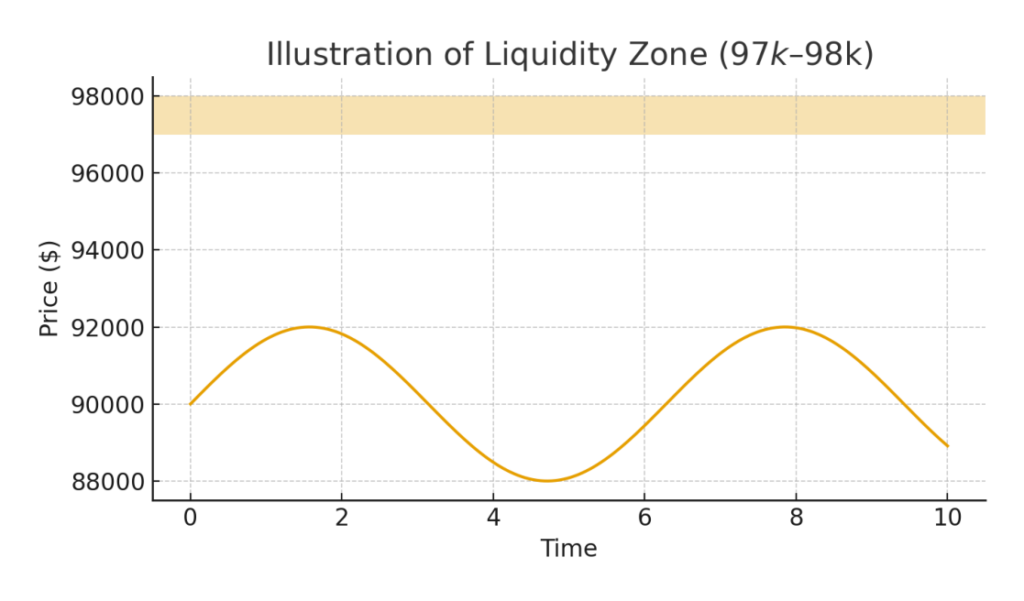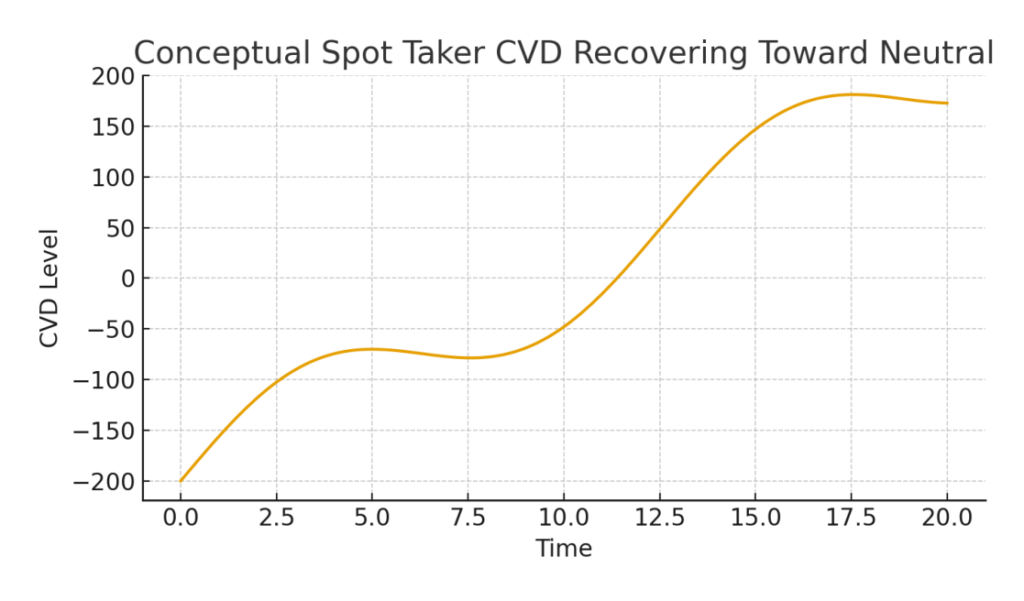
Main Points :
- Bitcoin holds firm above the critical $90,000 support zone during the U.S. Thanksgiving holiday, avoiding typical U.S.-driven sell pressure.
- Analysts highlight $93,000 and $97,000–$98,000 as the next major resistance targets before a renewed attempt at six-figure levels.
- Futures market leverage has been unwinding, laying the groundwork for a more sustainable long-term rally.
- On-chain indicators such as the spot taker CVD and futures retail-investor signal show clear signs of recovery and returning long-term capital.
- Market sentiment strengthens as liquidity pockets above $97,000 attract bullish traders’ attention.
I. Bitcoin Market Regains Momentum Over the Thanksgiving Holiday

The recent Bitcoin price behavior during the U.S. Thanksgiving period has once again sparked discussion of a renewed push toward the widely-anticipated $97,000 level. After briefly reaching weekly highs near $92,000, Bitcoin successfully defended the $90,000 support range—a key psychological and technical threshold.
This maintenance of structure occurred during a U.S. market holiday, when trading activity often drops sharply. Historically, low-liquidity U.S. holiday periods have increased short-term volatility, but this time, Bitcoin benefited from the absence of institutional sell pressure.
As a result, bullish analysts now see a clear upward continuation pattern forming. Prominent trader Michaël van de Poppe noted that if Bitcoin breaks the $93,000 resistance—an area corresponding to the early-2025 yearly open—momentum could accelerate into a new test of $100,000.
II. The Critical Resistance Zones: $93K and $97K–$98K
While $93,000 serves as the first hurdle, trader Daan Crypto Trades highlights a more significant level at $97,000–$98,000, where large clusters of liquidity have formed. These liquidity pockets are the result of “consistent large-scale selling” in recent weeks, creating a band of lower highs that mark the next target for any bullish breakout.

This zone also corresponds to a horizontal price range visible across market structure, reinforcing its significance. Traders agree that if Bitcoin decisively enters this band, a push to six-figure territory becomes increasingly probable.
One additional note is the possibility of a short-term retest of $88,000, which van de Poppe views as a healthy correction rather than a bearish signal. Overall, analysts continue to argue that the broader crypto bull cycle is “far from finished.”
III. On-Chain Indicators Show Clear “Progress”

On-chain data adds another layer of confidence. CryptoQuant contributor Maartunn points out that the spot market is recovering, supported by the spot taker cumulative volume delta (CVD) moving from negative toward neutral territory.
A negative CVD value earlier in November was one of the bearish concerns at the time when BTC briefly traded above $100,000. That downward pressure appears to be easing now, indicating that buyers are gradually regaining control.
Another CryptoQuant analyst, XWIN Research Japan, reports that signals across futures, spot markets, and on-chain metrics all indicate that the recent “high-leverage phase” is coming to an end. Retail investor activity in Bitcoin futures, a reliable indicator of market turning points, has switched to a green signal, historically aligning with bullish momentum shifts.
IV. Futures Market Deleveraging Strengthens Foundation for a Sustainable Rally
Leverage washouts have become increasingly visible in the futures market. Across major derivatives exchanges, the liquidation of highly leveraged long and short positions has created a more stable foundation for price continuation.
Excessive leverage tends to distort price movements and exaggerate volatility. Its reduction often precedes more organic price growth, driven by long-term capital rather than short-term speculation.
Current futures open interest and funding rate patterns align with this healthier structure. Analysts note that the market is transitioning from a speculative phase into a more fundamentally driven accumulation phase—a structure that historically precedes major bullish legs.
V. Market Sentiment Strengthens as Macro Signals Support Crypto Assets
Beyond internal crypto-market indicators, macroeconomic trends are also contributing to improving sentiment:
1. U.S. Dollar Weakness
A softer USD typically supports alternative assets and commodities. The current trend suggests continued interest in Bitcoin as a hedge against monetary expansion.
2. Rising Institutional Allocation
Major funds and corporate treasuries continue to increase their Bitcoin exposure, particularly following the global acceptance of spot Bitcoin ETFs.
3. Bitcoin Supply Illiquidity Growth
On-chain analysis shows that long-term holders are accumulating again, reducing the circulating supply available on exchanges. Historically this precedes strong upward rallies.
4. Risk-On Market Structure
Tech stocks, risk assets, and crypto have shown correlated upward momentum, suggesting the broader financial environment is supportive of further gains.
This combination of macro and crypto-native factors positions Bitcoin favorably for a potential surge in Q1–Q2 2026.📊 Figure 1: Conceptual Trend Illustration
Insert here:(Figure 1: btc_concept.png)
VI. What This Means for Investors Seeking the Next Crypto Opportunity
Readers in search of new revenue streams or emerging crypto assets should closely observe how Bitcoin’s behavior influences the broader digital asset ecosystem.
1. Altcoins Typically Follow Delayed Momentum
Historically, strong Bitcoin rallies trigger delayed but amplified movements across altcoins—especially mid-cap tokens and high-utility networks.
2. Spot Markets Becoming More Important
As leverage unwinds, spot accumulation becomes a clearer signal of long-term conviction. Tokens tied to real-world utility, interoperability, and DeFi infrastructure may gain traction.
3. Increased Demand for Non-Custodial and Layer-2 Wallet Solutions
With rising Bitcoin valuation and global adoption, decentralized wallets and cross-chain swap mechanisms are seeing growing real-world usage.
4. Institutional-Grade Tokens Gain Appeal
Stable yield-bearing digital products, tokenized real-world assets (RWA), payment tokens, and regulated utility tokens—such as corporate ecosystem tokens—may benefit from renewed bullishness.
The ongoing strengthening of Bitcoin’s market structure strengthens the narrative of crypto as a maturing global asset class.
VII. Conclusion: Bitcoin Shows “Real Progress”—$97,000 Is Back in Sight
Bitcoin’s resilience above $90,000, combined with clearer on-chain signals, declining leverage, and favorable macro trends, indicates that the market is building toward another major leg upward.
With liquidity zones forming around $97,000–$98,000 and analysts pointing toward the $100,000 region, the narrative of Bitcoin revisiting six-figure territory is no longer speculative—it is increasingly grounded in data and market structure.
For investors, this period represents a pivotal moment:
a chance to position ahead of broader market expansion not only in Bitcoin but across the multi-chain ecosystem.

